

Compact Muon Solenoid
LHC, CERN
| CMS-HIN-16-009 ; CERN-EP-2016-236 | ||
| Observation of charge-dependent azimuthal correlations in pPb collisions and its implication for the search for the chiral magnetic effect | ||
| CMS Collaboration | ||
| 1 October 2016 | ||
| Phys. Rev. Lett. 118 (2017) 122301 | ||
| Abstract: Charge-dependent azimuthal particle correlations with respect to the second-order event plane in pPb and PbPb collisions at a nucleon-nucleon center-of-mass energy of 5.02 TeV have been studied with the CMS experiment at the LHC. The measurement is performed with a three-particle correlation technique, using two particles with the same or opposite charge within the pseudorapidity range $| \eta | < $ 2.4, and a third particle measured in the hadron forward calorimeters (4.4 $ < | \eta | < $ 5). The observed differences between the same and opposite sign correlations, as functions of multiplicity and $\eta$ gap between the two charged particles, are of similar magnitude in pPb and PbPb collisions at the same multiplicities. These results pose a challenge for the interpretation of charge-dependent azimuthal correlations in heavy ion collisions in terms of the chiral magnetic effect. | ||
| Links: e-print arXiv:1610.00263 [nucl-ex] (PDF) ; CDS record ; inSPIRE record ; HepData record ; CADI line (restricted) ; | ||
| Figures | Summary | Additional Figures | References | CMS Publications |
|---|
| Figures | |

png pdf |
Figure 1:
The same (SS) and opposite sign (OS) three-particle correlator as a function of $ {\Delta \eta } \equiv |\eta _{\alpha }-\eta _{\beta }|$ for 185 $ \leq {N_\text {trk}^\text {offline}} < $ 220 in (a) pPb and (b) PbPb collisions at $ \sqrt{ s_{\mathrm{NN}} } = $ 5.02 TeV. The pPb results obtained with particle $c$ in Pb-going (solid markers) and p-going (open markers) sides are shown separately. Statistical and systematic uncertainties are indicated by the error bars and shaded regions, respectively. |

png pdf |
Figure 2:
The same sign (SS) and opposite sign (OS) three-particle correlator averaged over $ {| \eta _{\alpha }-\eta _{\beta } | } < $ 1.6 as a function of ${N_\text {trk}^\text {offline}}$ in pPb and PbPb collisions at $ {\sqrt {\smash [b]{s_{_\mathrm {NN}}}}} = $ 5.02 TeV are shown. Statistical and systematic uncertainties are indicated by the error bars and shaded regions, respectively. |
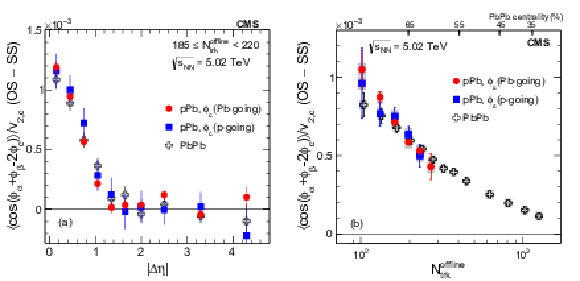
png pdf |
Figure 3:
The difference of the opposite sign (OS) and same sign (SS) three-particle correlators (a) as a function of $|\eta _{\alpha }-\eta _{\beta }|$ for 185 $ \leq {N_\text {trk}^\text {offline}} < $ 220 and (b) as a function of ${N_\text {trk}^\text {offline}} $, averaged over $ {| \eta _{\alpha }-\eta _{\beta } | }< $ 1.6, in pPb and PbPb collisions at $ \sqrt{ s_{\mathrm{NN}} } = $ 5.02 TeV. The pPb results are obtained with particle $c$ from Pb- and p-going sides separately. Statistical and systematic uncertainties are indicated by the error bars and shaded regions, respectively. |
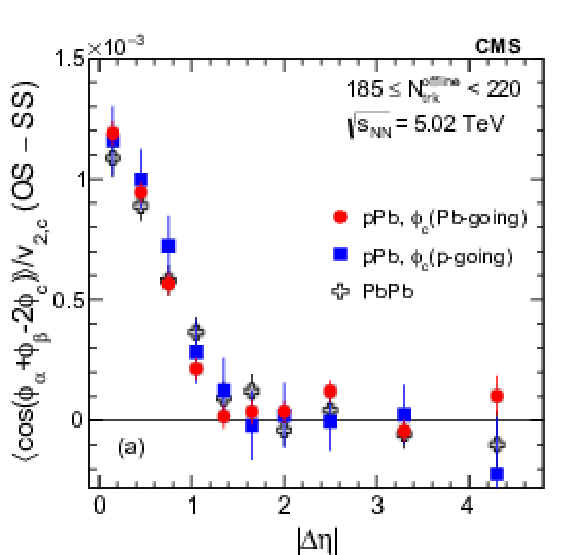
png pdf |
Figure 3-a:
The difference of the opposite sign (OS) and same sign (SS) three-particle correlators as a function of $|\eta _{\alpha }-\eta _{\beta }|$ for 185 $ \leq {N_\text {trk}^\text {offline}} < $ 220, averaged over $ {| \eta _{\alpha }-\eta _{\beta } | }< $ 1.6, in pPb and PbPb collisions at $ \sqrt{ s_{\mathrm{NN}} } = $ 5.02 TeV. The pPb results are obtained with particle $c$ from Pb- and p-going sides separately. Statistical and systematic uncertainties are indicated by the error bars and shaded regions, respectively. |
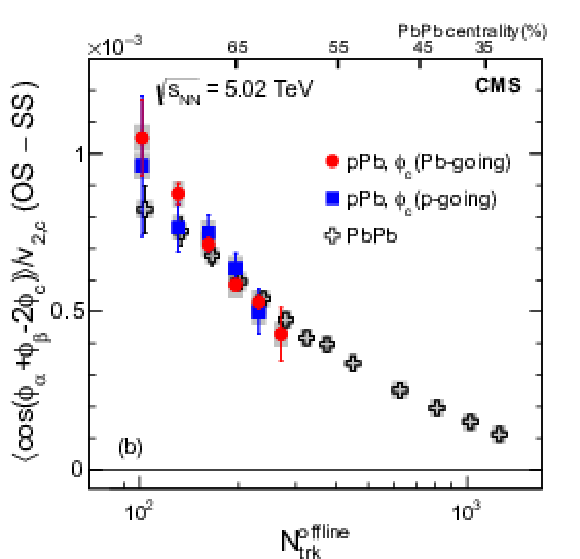
png pdf |
Figure 3-b:
The difference of the opposite sign (OS) and same sign (SS) three-particle correlators as a function of ${N_\text {trk}^\text {offline}} $, averaged over $ {| \eta _{\alpha }-\eta _{\beta } | }< $ 1.6, in pPb and PbPb collisions at $ \sqrt{ s_{\mathrm{NN}} } = $ 5.02 TeV. The pPb results are obtained with particle $c$ from Pb- and p-going sides separately. Statistical and systematic uncertainties are indicated by the error bars and shaded regions, respectively. |
| Summary |
| In summary, charge-dependent azimuthal correlations of same and opposite sign particles with respect to the second-order event plane have been measured in pPb and PbPb collisions at $ \sqrt{s_{\mathrm{NN}} } = $ 5.02 TeV by the CMS experiment at the LHC. The correlation is extracted via a three particle correlator as functions of particle $ \Delta \eta $ and charged-particle multiplicity of the event. The difference between same and opposite sign particles as functions of $ \Delta \eta $ and multiplicity is found to agree for pPb and PbPb collisions, possibly indicating a common underlying mechanism that generates the observed correlation. These results challenge the CME interpretation for the observed charge-dependent azimuthal correlations in nucleus-nucleus collisions at RHIC and the LHC. |
| Additional Figures | |
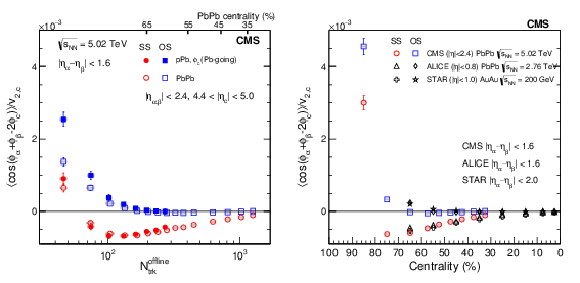
png pdf |
Additional Figure 1:
In (a), the same sign (SS) and opposite sign (OS) three-particle correlator averaged over $|\eta _{\alpha }-\eta _{\beta }|<$ 1.6 as a function of $ {N_\text {trk}^\text {offline}} $ in pPb and PbPb collisions at $ \sqrt{s_{\mathrm {NN}}} =$ 5.02 TeV are shown. In (b), the same correlation as a function of centrality is presented in PbPb collisions at $ \sqrt{s_{\mathrm {NN}}} =$ 5.02 TeV from CMS, at $ \sqrt{s_{\mathrm {NN}}} =$ 2.76 TeV from ALICE [1], and in AuAu collisions at $ \sqrt{s_{\mathrm {NN}}} =$ 0.2TeV from STAR [2]. The bars (boxes) represent statistical (systematic) point-by-point uncertainties. |

png pdf |
Additional Figure 2:
The same sign (SS) and opposite sign (OS) three-particle correlator averaged over $|\eta _{\alpha }-\eta _{\beta }|<$ 1.6 as a function of centrality is presented in PbPb collisions at $ \sqrt{s_{\mathrm {NN}}} =$ 5.02 TeV from CMS with $ {| \eta | }<$ 2.4 and $ {| \eta | }< $ 0.8, at $ \sqrt{s_{\mathrm {NN}}} =$ 2.76 TeV from ALICE [1], and in AuAu collisions at $ \sqrt{s_{\mathrm {NN}}} =$ 0.2TeV from STAR [2]. The bars (boxes) represent statistical (systematic) point-by-point uncertainties. |
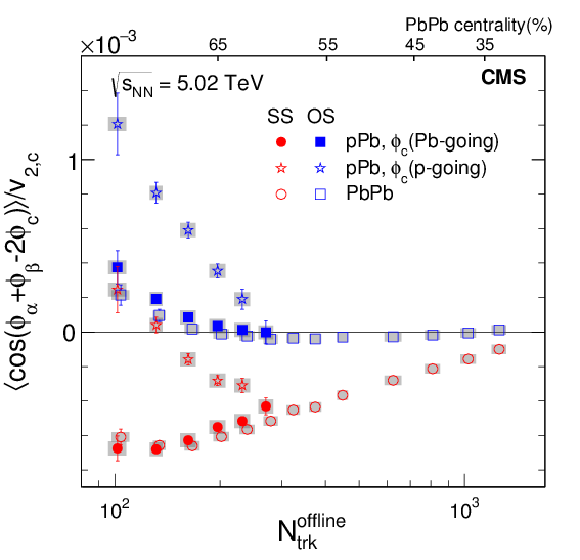
png pdf |
Additional Figure 3:
The same sign (SS) and opposite sign (OS) three-particle correlator averaged over $|\eta _{\alpha }-\eta _{\beta }|<$ 1.6 as a function of $ {N_\text {trk}^\text {offline}} $ in pPb and PbPb collisions at $ \sqrt{s_{\mathrm {NN}}} =$ 5.02 TeV are shown. Particle $c$ is measured from both $HF_{+}$ and $HF_{-}$. Statistical and systematic uncertainties are indicated by the error bars and shaded regions, respectively. |

png pdf |
Additional Figure 4:
The same sign (SS) and opposite sign (OS) three-particle correlator as a function of $ {\Delta \eta } $ is presented in PbPb collisions at $ \sqrt{s_{\mathrm {NN}}} =$ 5.02 TeV for 60-70% centrality, with particle $\alpha , \beta $ within $ {| \eta | }<$ 2.4 and particle $c$ between 4.4 $ < {| \eta | }< $ 5.0 as default kinematic range, and shown with particle $\alpha , \beta $ within $ {| \eta | }< $ 0.8 and particle $c$ between 4.5 $ < {| \eta | }< $ 5.0. The bars (boxes) represent statistical (systematic) point-by-point uncertainties. |
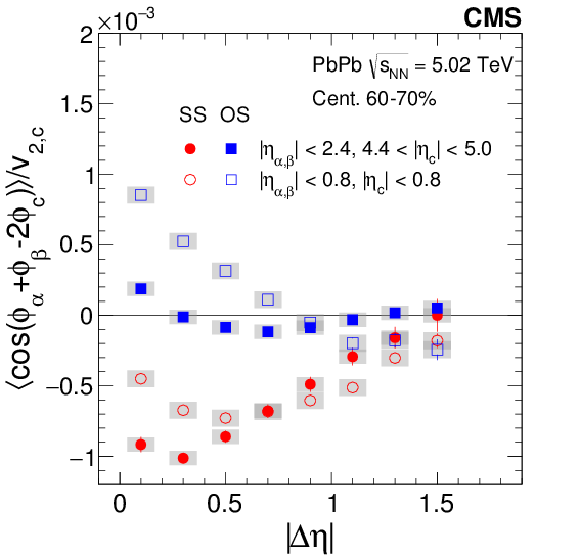
png pdf |
Additional Figure 5:
The same sign (SS) and opposite sign (OS) three-particle correlator as a function of $ {\Delta \eta } $ is presented in PbPb collisions at $ \sqrt{s_{\mathrm {NN}}} =$ 5.02 TeV for 60-70% centrality, with particle $\alpha , \beta $ within $ {| \eta | }<$ 2.4 and particle $c$ between 4.4 $ < {| \eta | }< $ 5.0 as default kinematic range, and shown with particle $\alpha , \beta $ within $ {| \eta | }< $ 0.8 and particle $c$ within $ {| \eta | }< $ 0.8. The bars (boxes) represent statistical (systematic) point-by-point uncertainties. |

png pdf |
Additional Figure 6:
The difference between the opposite sign (OS) and the same sign (SS) three-particle correlator as a function of $ {\Delta \eta } $ is presented in PbPb collisions at $ \sqrt{s_{\mathrm {NN}}} =$ 5.02 TeV for 60-70% centrality, with particle $\alpha , \beta $ within $ {| \eta | }<$ 2.4 and particle $c$ between 4.4 $ < {| \eta | }< $ 5.0 as default kinematic range, and shown with particle $\alpha , \beta $ within $ {| \eta | }< $ 0.8 and particle $c$ between 4.5 $ < {| \eta | }< $ 5.0. The bars (boxes) represent statistical (systematic) point-by-point uncertainties. |
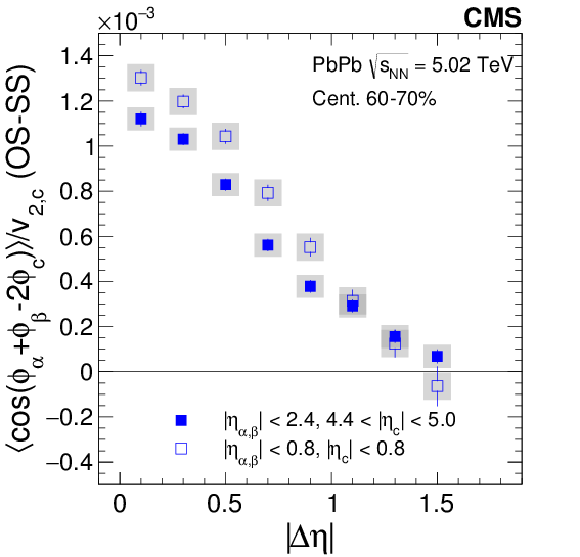
png pdf |
Additional Figure 7:
The difference between the opposite sign (OS) and the same sign (SS) three-particle correlator as a function of $ {\Delta \eta } $ is presented in PbPb collisions at $ \sqrt{s_{\mathrm {NN}}} =$ 5.02 TeV for 60-70% centrality, with particle $\alpha , \beta $ within $ {| \eta | }<$ 2.4 and particle $c$ between 4.4 $ < {| \eta | }< $ 5.0 as default kinematic range, and shown with particle $\alpha , \beta $ within $ {| \eta | }< $ 0.8 and particle $c$ within $ {| \eta | }< $ 0.8. The bars (boxes) represent statistical (systematic) point-by-point uncertainties. |
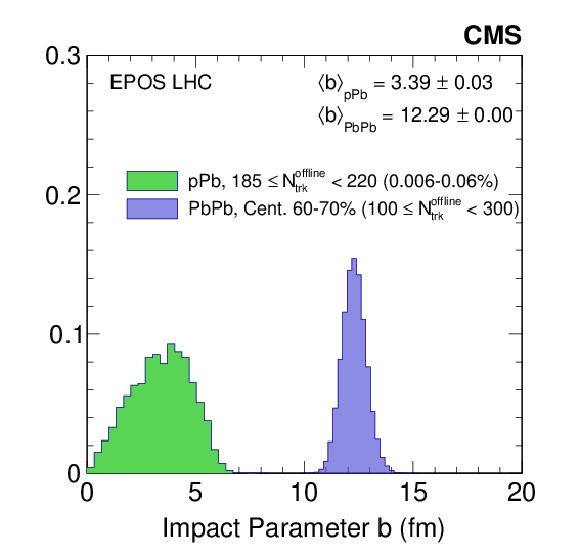
png pdf |
Additional Figure 8:
The impact parameter distributions from epos lhc simulation of pPb and PbPb collisions at $ \sqrt{s_{\mathrm {NN}}} =$ 5.02 TeV are presented. For pPb , the events with selection of top 0.006-0.06% of the multiplicity distribution are shown, equvalent to the multiplicity class $185 \leq {N_\text {trk}^\text {offline}} < 220$ in data. For PbPb , the events with centrality selection of 60-70% are shown, which is an equvalent to the multiplicity class 100 $ \leq {N_\text {trk}^\text {offline}} < $ 300 in data. |
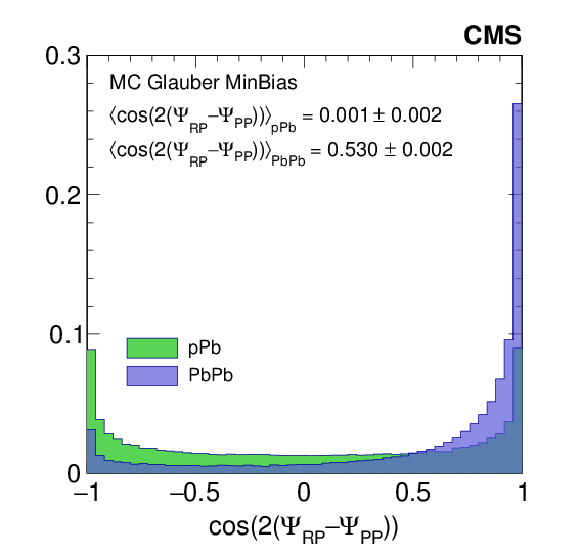
png pdf |
Additional Figure 9:
The cosine of the relative angle between the reaction plane, denoted as $\Psi _{\rm RP}$, and the participant plane, denoted as $\Psi _{\rm PP}$, from MC Glauber simulation of pPb and PbPb collisions at $ \sqrt{s_{\mathrm {NN}}} =$ 5.02 TeV are presented. The average of the distributions are also shown for both pPb and PbPb collisions. |
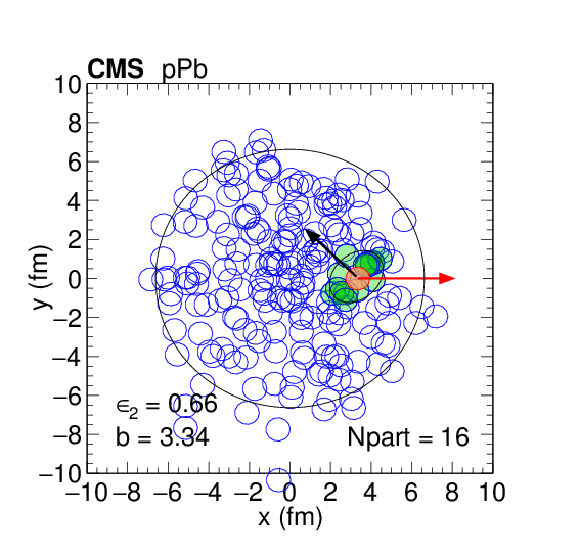
png pdf |
Additional Figure 10:
Event display of one high-multiplicity pPb event using MC Glauber simulation at $ \sqrt{s_{\mathrm {NN}}} =$ 5.02 TeV is shown. The red circle is the proton projectile, the green circles are the participant nucleons, and the blue circles are the spectator nucleons. The red and black arrow refer to the angle of the reaction plane ($\Psi _{\rm RP}$) and the participant plane ($\Psi _{\rm PP}$) in the transverse direction. |
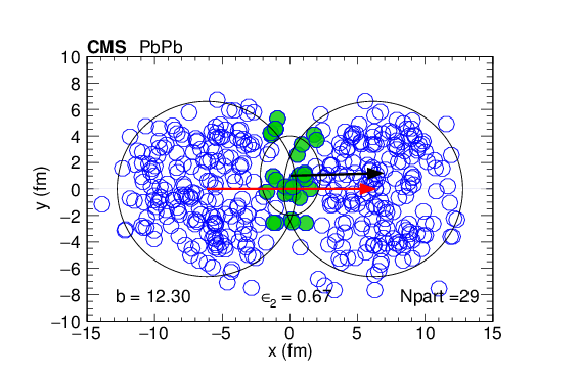
png pdf |
Additional Figure 11:
Event display of one peripheral PbPb event using MC Glauber simulation at $ \sqrt{s_{\mathrm {NN}}} =$ 5.02 TeV is shown. The green circles are the participant nucleons, and the blue circles are the spectator nucleons. The red and black arrow refer to the angle of the reaction plane ($\Psi _{\rm RP}$) and the participant plane ($\Psi _{\rm PP}$) in the transverse direction. |
| References | ||||
| 1 | T. D. Lee | A theory of spontaneous $ T $ violation | PRD 8 (1973) 1226 | |
| 2 | T. D. Lee and G. C. Wick | Vacuum stability and vacuum excitation in a spin-0 field theory | PRD 9 (1974) 2291 | |
| 3 | P. D. Morley and I. A. Schmidt | Strong p, cp, t violations in heavy-ion collisions | Z. Phys. C 26 (1985) 627 | |
| 4 | D. Kharzeev, R. D. Pisarski, and M. H. G. Tytgat | Possibility of spontaneous parity violation in hot QCD | PRL 81 (1998) 512 | hep-ph/9804221 |
| 5 | D. Kharzeev | Parity violation in hot QCD: Why it can happen, and how to look for it | PLB 633 (2006) 260 | hep-ph/0406125 |
| 6 | STAR Collaboration | Azimuthal Charged-Particle Correlations and Possible Local Strong Parity Violation | PRL 103 (2009) 251601 | 0909.1739 |
| 7 | STAR Collaboration | Observation of charge-dependent azimuthal correlations and possible local strong parity violation in heavy-ion collisions | PRC 81 (2010) 054908 | 0909.1717 |
| 8 | STAR Collaboration | Measurement of charge multiplicity asymmetry correlations in high-energy nucleus-nucleus collisions at $ \sqrt{s_{\mathrm{NN}}}\ = $ 200 GeV | PRC 89 (2014) 044908 | 1303.0901 |
| 9 | STAR Collaboration | Beam-Energy Dependence of Charge Separation along the Magnetic Field in Au+Au Collisions at RHIC | PRL 113 (2014) 052302 | 1404.1433 |
| 10 | STAR Collaboration | Fluctuations of charge separation perpendicular to the event plane and local parity violation in $ \sqrt{s_{\mathrm{NN}}}\ = $ 200 GeV Au+Au collisions at the BNL Relativistic Heavy Ion Collider | PRC 88 (2013) 064911 | 1302.3802 |
| 11 | ALICE Collaboration | Charge separation relative to the reaction plane in Pb-Pb collisions at $ \sqrt{s_{\mathrm{NN}}}\ = $ 2.76 TeV | PRL 110 (2013) 012301 | 1207.0900 |
| 12 | S. A. Voloshin | Parity violation in hot QCD: How to detect it | PRC 70 (2004) 057901 | hep-ph/0406311 |
| 13 | F. Wang | Effects of cluster particle correlations on local parity violation observables | PRC 81 (2010) 064902 | 0911.1482 |
| 14 | A. Bzdak, V. Koch, and J. Liao | Azimuthal correlations from transverse momentum conservation and possible local parity violation | PRC 83 (2011) 014905 | 1008.4919 |
| 15 | S. Schlichting and S. Pratt | Charge conservation at energies available at the BNL Relativistic Heavy Ion Collider and contributions to local parity violation observables | PRC 83 (2011) 014913 | 1009.4283 |
| 16 | G.-L. Ma and B. Zhang | Effects of final state interactions on charge separation in relativistic heavy ion collisions | PLB 700 (2011) 39 | 1101.1701 |
| 17 | T. Pierog et al. | EPOS LHC: Test of collective hadronization with data measured at the CERN Large Hadron Collider | PRC 92 (2015) 034906 | |
| 18 | D. E. Kharzeev, J. Liao, S. A. Voloshin, and G. Wang | Chiral magnetic and vortical effects in high-energy nuclear collisions---A status report | Prog. Part. Nucl. Phys. 88 (2016) 1 | 1511.04050 |
| 19 | CMS Collaboration | Observation of long-range, near-side angular correlations in proton-proton collisions at the LHC | JHEP 09 (2010) 091 | CMS-QCD-10-002 1009.4122 |
| 20 | ATLAS Collaboration | Observation of long-range elliptic azimuthal anisotropies in $ \sqrt{s} = $ 13 and 2.76 TeV pp collisions with the ATLAS detector | PRL 116 (2016) 172301 | 1509.04776 |
| 21 | CMS Collaboration | Measurement of long-range near-side two-particle angular correlations in $ pp $ collisions at $ \sqrt{s} = $ 13 TeV | PRL 116 (2016) 172302 | CMS-FSQ-15-002 1510.03068 |
| 22 | CMS Collaboration | Evidence for collectivity in pp collisions at the LHC | PLB 765 (2017) 193 | CMS-HIN-16-010 1606.06198 |
| 23 | CMS Collaboration | Observation of long-range, near-side angular correlations in pPb collisions at the LHC | PLB 718 (2013) 795 | CMS-HIN-12-015 1210.5482 |
| 24 | ALICE Collaboration | Long-range angular correlations on the near and away side in p-PB collisions at $ \sqrt{s_{\mathrm{NN}}} = $ 5.02 TeV | PLB 719 (2013) 29 | 1212.2001 |
| 25 | ATLAS Collaboration | Observation of associated near-side and away-side long-range correlations in $ \sqrt{s_{\mathrm{NN}}} = $ 5.02 TeV proton-lead collisions with the ATLAS detector | PRL 110 (2013) 182302 | 1212.5198 |
| 26 | LHCb Collaboration | Measurements of long-range near-side angular correlations in $ \sqrt{s_{\mathrm{NN}}} = $ 5 TeV proton-lead collisions in the forward region | PLB 762 (2016) 473 | 1512.00439 |
| 27 | CMS Collaboration | Long-range two-particle correlations of strange hadrons with charged particles in pPb and PbPb collisions at LHC energies | PLB 742 (2015) 200 | CMS-HIN-14-002 1409.3392 |
| 28 | ALICE Collaboration | Long-range angular correlations of pi, K and p in p--Pb collisions at $ \sqrt{s_{\mathrm{NN}}}\ = $ 5.02 TeV | PLB 726 (2013) 164 | 1307.3237 |
| 29 | CMS Collaboration | Multiplicity and transverse momentum dependence of two- and four-particle correlations in $ \mathrm{ p Pb }\ $ and $ \mathrm{ Pp Pb }\ $ collisions | PLB 724 (2013) 213 | CMS-HIN-13-002 1305.0609 |
| 30 | ATLAS Collaboration | Measurement of long-range pseudorapidity correlations and azimuthal harmonics in $ \sqrt{s_{\mathrm{NN}}}\ = $ 5.02 TeV proton-lead collisions with the ATLAS detector | PRC 90 (2014) 044906 | 1409.1792 |
| 31 | CMS Collaboration | Evidence for collective multiparticle correlations in $ p $-Pb collisions | PRL 115 (2015) 012301 | CMS-HIN-14-006 1502.05382 |
| 32 | K. Dusling, W. Li, and B. Schenke | Novel collective phenomena in high-energy proton-proton and proton-nucleus collisions | Int. J. Mod. Phys. E 25 (2016) 1630002 | 1509.07939 |
| 33 | B. Alver, M. Baker, C. Loizides, and P. Steinberg | The PHOBOS Glauber Monte Carlo | 0805.4411 | |
| 34 | CMS Collaboration | Multiplicity and rapidity dependence of strange hadron production in pp, pPb, and PbPb collisions at the LHC | PLB 768 (2017) 103 | CMS-HIN-15-006 1605.06699 |
| 35 | CMS Collaboration | Description and performance of track and primary-vertex reconstruction with the CMS tracker | JINST 9 (2014) P10009 | CMS-TRK-11-001 1405.6569 |
| 36 | CMS Collaboration | The CMS experiment at the CERN LHC | JINST 3 (2008) S08004 | CMS-00-001 |
| 37 | A. Bilandzic et al. | Generic framework for anisotropic flow analyses with multiparticle azimuthal correlations | PRC 89 (2014), no. 6, 064904 | 1312.3572 |
| 38 | I. Selyuzhenkov and S. Voloshin | Effects of nonuniform acceptance in anisotropic flow measurement | PRC 77 (2008) 034904 | 0707.4672 |
| 39 | GEANT4 Collaboration | GEANT4---a simulation toolkit | NIMA 506 (2003) 250 | |

|
Compact Muon Solenoid LHC, CERN |

|

|

|

|

|

|